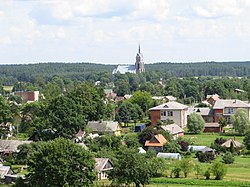
This article is about the demographic features of the population of Lithuania, including population density, ethnicity, level of education, health, economic status, and religious affiliations.
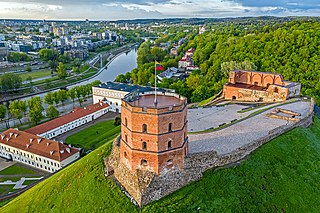
Vilnius is the capital and largest city of Lithuania, with a population of 592,389 as of 2022 or 622,737. The population of Vilnius's functional urban area, which stretches beyond the city limits, is estimated at 718,507, while according to the Vilnius territorial health insurance fund, there were 732,421 permanent inhabitants as of October 2020 in Vilnius city and Vilnius district municipalities combined. Vilnius is situated in southeastern Lithuania and is the second-largest city in the Baltic states, but according to the Bank of Latvia is expected to become the largest before 2025. It is the seat of Lithuania's national government and the Vilnius District Municipality.

Ashmyany is a town in Grodno Region, Belarus, located at 50 km from Vilnius. The town is Ashmyany District's capital. It lies in Ashmyanka's river basin.

Sejny is a town in north-eastern Poland and the capital of Sejny County, in Podlaskie Voivodeship, close to the northern border with Lithuania and Belarus. It is located in the eastern part of the Suwałki Lake Area, on the Marycha river, being a tributary of the Czarna Hańcza. As of 1999 it had almost 6,500 permanent inhabitants, with a strong seasonal increase during the tourist season.
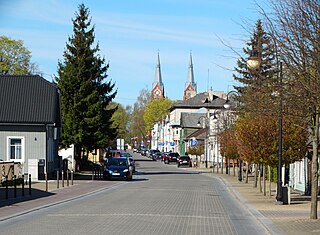
Jurbarkas is a city in Tauragė County, in Samogitia, Lithuania. Jurbarkas is located in the historic land of Karšuva. It is on the right-hand shore of the Nemunas at its confluence with the tributaries Mituva and Imsrė. The town became an important road junction after a bridge was built over the Nemunas in 1978.

Kretinga is a City in Klaipėda County, Lithuania. It is the capital of the Kretinga district municipality. It is located 12 km (7.5 mi) east of the popular Baltic Sea resort town of Palanga, and about 25 km (16 mi) north of Lithuania's 3rd largest city and principal seaport, Klaipėda.

Merkinė is a town in the Dzūkija National Park in Lithuania, located at the confluence of the Merkys, Stangė, and Nemunas rivers. Merkinė is one of the oldest settlements in Lithuania. The first settlers inhabited the confluence of Merkys and Nemunas in the 9th-10th century BC, at the end of the Paleolithic. On top of Merkinė hill-fort stood one of the most important Lithuanian castles, built in the 13th century, which guarded against invasions of the Teutonic Order. Merkinė was a part of a strategic triangle - Kaunas - Vilnius - Merkinė, protected with the chains of hillforts and castles. The center of Merkinė town is a state-protected urbanistic monument. Merkinė is an important point of Lithuania's domestic tourism.

Eišiškės is a small city in southeastern Lithuania on the border with Belarus. It is situated on a small group of hills, surrounded by marshy valley of Verseka and Dumblė Rivers. The rivers divide the town into two parts; the northern part is called Jurzdika. As of the census in 2011, Eišiškės had a population of 3,416. It has a hospital and two high schools.
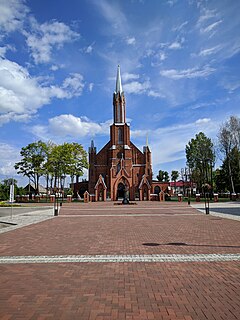
Kaišiadorys is a city in central Lithuania. It is situated between Vilnius and Kaunas. Kaišiadorys is one of six Lithuanian diocese centres. It is home to the Cathedral of the Transfiguration of Christ built in 1932. The Lithuanian Veterinary Institute is located there.

Švenčionys is the town, located 84 kilometers (52 mi) north of Vilnius in Lithuania. It is the capital of the Švenčionys district municipality. As of 2020, it had population of 4,065 of which about 17% is part of the Polish minority in Lithuania.

Hlybokaye or Glubokoye is a town in Vitebsk Region, Belarus, the capital of Hlybokaye Raion. The city is located on the international road from Polotsk to Vilnius with the historic railway line to Woropajewo (Варапаева) completed in 1932 in the interwar Poland. It has 18,200 inhabitants as of 2010.

According to the 2021 census, the predominant religion in Lithuania is Christianity, with the largest confession being that of the Catholic Church. There are smaller groups of Orthodox Christians, Evangelical Lutherans, members of Reformed churches, other Protestants, Jews and Muslims as well as people of other religions.

Dieveniškės is a town in the Vilnius County of Lithuania, about 6 kilometres (3.7 mi) from the Belarusian border in the so-called Dieveniškės appendix. It is surrounded by the Dieveniškės Regional Park.
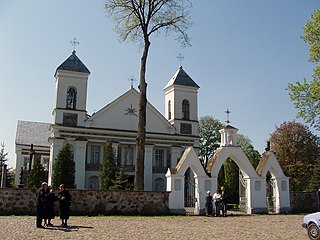
Valkininkai is a historic town in Valkininkų (Valkininkai) eldership, Varėna District Municipality, Alytus County, Lithuania, located about 22 km (14 mi) northeast from Varėna and about 55 km (34 mi) southwest from Vilnius. At the Lithuanian census of 2001, its population was 238 and at the census of 2011 it was 229.
Mother Bertranda, O.P., later known as Anna Borkowska, was a Polish cloistered Dominican nun who served as the prioress of her monastery in Kolonia Wileńska near Wilno. She was a graduate of the University of Kraków who had entered the monastery after her studies. During World War II, under her leadership, the nuns of the monastery sheltered 17 young Jewish activists from Vilnius Ghetto and helped the Jewish Partisan Organization (FPO) by smuggling weapons. In recognition of this, in 1984 she was awarded the title of Righteous among the Nations by Yad Vashem.

Bezdonys is a town in Lithuania, located to the north of Vilnius, within the Vilnius district municipality. It is best known for the 1908 Bezdany raid, one of the most daring and successful train robberies in history. According to the Lithuanian census of 2011, the town had 743 inhabitants.

Vandžiogala is a small town in Kaunas County, Kaunas district municipality in central Lithuania. It is located 29 km (18 mi) north of Kaunas next to Urka brook. A Holy Trinity church was built in Vandžiogala in 1830.

Maišiagala is a historic town in Vilnius district municipality, Lithuania. It is located about 25 km (16 mi) northwest of Vilnius near the Vilnius–Panevėžys highway. According to the 2021 census, it had a population of 1 562, a decrease from 1,636, registered at the 2011 census.
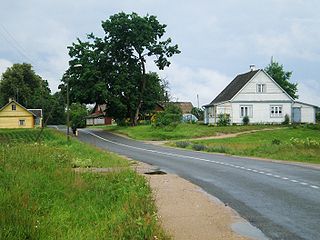
Labanoras [ɫaba'noːras], Polish: Łabonary, is a small town within the Labanoras Regional Park in Lithuania. It is situated on Labanoras Lake and is surrounded by the Labanoras Regional Park, the largest regional park in Lithuania. As a center of the Labanoras Park, the town attracts tourists. A hotel and restaurant were opened in a former school building in 2003. According to the Lithuanian census of 2011, the town had 59 residents.

Darsūniškis is a settlement on the Nemunas River in Kaišiadorys District Municipality, western Lithuania. The village is one of the oldest settlements in Lithuania and dates back to the 14th century.
